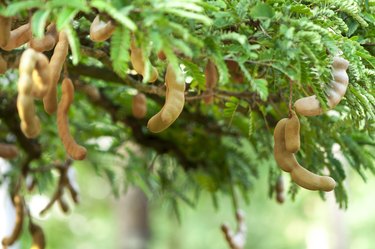
Part of the fun of going to a new restaurant, or trying a new kind of food, is learning about new ingredients. This is especially true for Westerners eating Asian food, with its diverse culinary cultures and its whole new world of unfamiliar colors, flavors and textures. One such ingredient is tamarind, which provides many dishes with a distinctively fruity tang. It is available at Asian markets in two common forms.
About Tamarind
Video of the Day
The tamarind is native to East Africa, but its virtues as a shade tree and food ingredient have helped it spread throughout the world's tropical regions. The fruit grows in the shape of long, leathery pods that resemble beans. As they ripen and mature, the outer skin becomes a hard, brittle shell and the pulp inside dries to a brown, sticky pulp. This is pressed into blocks for commercial sale, with or without the hard seeds. The tangy fruit is used like lemon or lime juice to add a refreshingly acidic accent to foods and sauces.
Video of the Day
Using Tamarind Pulp
Tamarind pulp usually is sold in the form of a small shrink-wrapped package, compressed and very dense. To use it in a recipe, cut off a piece from your block of pulp and place it in a measuring cup or mixing bowl. Cover the pulp with boiling water and let it sit for at least five minutes, stirring occasionally. Strain the liquid, picking the seeds from your strainer and pushing as much pulp through it as you can manage. The end result should be a thin, brown sticky paste.
Using Tamarind Paste
Tamarind paste is a convenience product, very similar in its way to the garlic or herb pastes sold in the produce section of your supermarket. Tamarind paste is tamarind pulp with the seeds and fibers removed, just as you would at home. It is packed in glass jars, or occasionally placed in plastic squeeze tubes like toothpaste. Depending on the brand and its quality, the paste may contain sweeteners or preservatives. This type of paste is smooth and contains no seeds or fibers, and requires no soaking. It can be used straight from the jar.
Using Tamarind
In most uses, the difference between tamarind pulp and tamarind paste is small. Tamarind paste is more convenient because it can be added directly to dishes, saving both time and effort. Some argue that freshly soaked tamarind pulp has a better, fresher flavor, but most cooks see little difference. Tamarind is used in a great variety of dishes in India, Southeast Asia and the Middle East, including soups, stir fries, noodle dishes and desserts. It's also the sour ingredient in Worcestershire sauce.